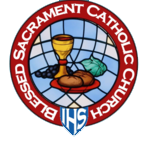Blessed Sacrament Young Archeologists Make A Lasting Impact

Blessed Sacrament sixth-graders Chantelle Sakalauskas, Connor Knight and Peyten Bowers pin a flag at a previously undocumented petroglyph on the western shore of Utah Lake. (John McHugh/Blessed Sacrament)
This summer, about 25 Blessed Sacrament students will be getting fresh air and exercise for hours at a time, but not by riding their bicycles or shooting hoops. Rather these youngsters will be helping the Utah Rock Art Research Association locate and identify Native American artifacts.
Already this school year, the group has traveled to sites west of Utah Lake several times as well as in Fremont State Park and Nine Mile Canyon, preserving rock art.
“We’re working with the National Park Service, BLM (Bureau of Land Management) and URARA in an effort to get young people out to help preserve and conserve rock art as a pilot program with the URARA,” fifth-grade teacher John McHugh said. “The kids are doing real archeology work as entry-level archeologists.”
The association has a mission to study, research and preserve the value of rock art as well as understand and enjoy rock art sites.
McHugh said the pilot program was made possible with his archeology background and having connections with archeologists in the field. He began by introducing an after-school club at his school to teach them about petroglyphs and pictographs.
“I thought I’d have six or seven kids join just to see rock art, but it springboarded and we have 25 kids who want to go in the field to sift artifacts. It’s definitely not a typical after-school club,” he said.
McHugh also said when the federal government cut back financial support for natural resources, archeologists welcomed the youth trained to help. They also have traveled with two state archeologists and have the equivalent of one semester of college knowledge, he said.
However, these fifth- through eighth-graders, nicknamed the Blessed Sacrament Shovel Bums, don’t just don reflective vests and walk out and take a shovel to the dirt, hoping to find pieces of Native American pottery of arrowheads.
“These students have learned to read topographical maps, accurately record their coordinates with GPS devices, take compass bearings, know how to properly fill out rock art forms, sketch and photograph the rock art images to scale, all before they shovel in the Smith Archeological Conservancy, which is north of Saratoga Springs. They can identify the kinds of rock, how old the patina is, and everything needed to know about rock art panels. The site is amazing, with about 300 panels, some of the oldest in Utah,” McHugh said.
During the school year, from late August to November and again in the spring, the Blessed Sacrament Shovel Bums spent about four hours “standing in the exact footprints of Native Americans.”
“The kids love it and it has become special to them; it’s become a part of them,” he said. “Their young souls give new perspective, fresh eyes as they are immersed in it. They know that an atlatl, for example, dates pre-100 AD and a bow and arrow will be after that. They can date arrowheads and know which culture used it as well as what animal they were hunting with it. These kids understand and respect sacred sites and now have a deep passion for Native American culture expressed in rock art,” he said.
Some pieces the students excavated, with permission last fall in Nine Mile Canyon, they cleaned and cataloged at Utah State University Eastern Prehistoric Museum in Price this spring, after consulting a Native American elder and BLM archeologist.
In the fall, two students, sixth-grader Alison Green and seventh-grader Isabella Pickers, presented their group’s findings and appreciation of rock art at the URARA Symposium, which was held in Bluffdale.
“Their energy and passion were off the charts,” McHugh said.
This summer, in addition to continuing to record prehistoric rock art sites at the Smith Archaeological Conservancy for the State Historic Preservation Office, the Shovel Bums planned to visit an undocumented prehistoric summer solstice rock art site near Vernal with the BLM.
The club also will receive the American Rock Art Research Association’s Education Award in Flagstaff in mid-June, which comes with a $500 check to support future research ventures.
McHugh has been teaching 27 years, but it wasn’t until recently he began at Blessed Sacrament.
“I’ve found private schools will welcome extra curriculum and I know from my background, Catholic schools enforce good behavior so the combination has allowed me to share my passion and knowledge, knowing the kids will be both helpful and respectful,” he said. “We begin with rock art etiquette, but they are the ones appreciating and preserving rock art for future generations.”

